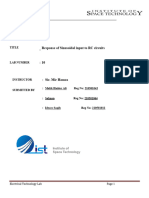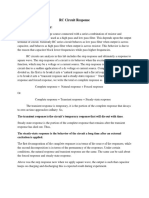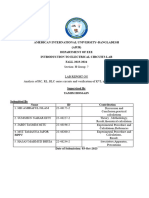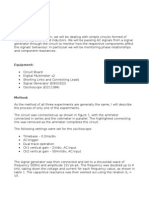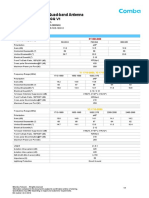RC Circuit Experiment
Objective
To explore the response of an RC circuit to an AC signal using a signal generator and an
oscilloscope and to understand its special filtering characteristics.
Principle
A basic RC circuit, as shown in Figure (1), consists of a resistor (R) and a capacitor (C)
connected in series with an AC power source (S). The output signal of S can be represented
as follows, where V₀ is the peak value of the AC voltage, ω is the angular frequency, and Rₛ
is the impedance of the AC power source S. The total resistance is given by Rₜ = R + R ₛ.
According to Kirchhoff's Law:
V₀ = IR + (1/C) ∫ I dt (Equation 1)
If we define I as the current in the circuit and Q as the charge, then the voltage caused by
the resistor is:
V_R = IR (Equation 2)
The voltage accumulated across the capacitor is:
V_C = Q/C (Equation 3)
Substituting equations (2) and (3) into equation (1), we obtain:
V₀ = IR + Q/C (Equation 4)
Solving the differential equation (4), we get
I = (V₀ / Z) * e^(-t/τ), where Z = √(R² + (1/ωC)²) and τ = RC
If the oscilloscope is connected across the capacitor, as shown in Figure (2):
V_C = V₀ * (1 / √(1 + (ωRC)²))
The peak value of V_C, denoted as V_C₀, is given by:
V_C₀ = V₀ * (1 / √(1 + (ωRC)²))
From equation (7), the frequency response curve is as shown in Figure (3). When
ω is very small (ω → 0), V_C₀ → V₀; when ω is very large (ω → ∞), V_C₀ ≈ 0. At the
critical frequency:
ω_C = 1 / RC
�Therefore, the circuit in Figure (2) is called a low-pass filter, where ω_C is the
cutoff frequency. In other words, only low-frequency signals (ω < ω_C) allow
most of the input voltage V₀ to appear across the capacitor, while high-frequency
signals (ω > ω_C) are filtered out, resulting in almost no voltage across the
capacitor (V_C₀ ≈ 0).
Similarly, if the oscilloscope is connected across the resistor, as shown in Figure (4):
V_R = V₀ * (ωRC / √(1 + (ωRC)²))
From equation (9), the frequency response curve is as shown in Figure (5). When
ω is very small (ω → 0), V_R₀ ≈ 0; when ω is very large (ω → ∞), V_R₀ → V₀. At the
critical frequency:
ω_R = 1 / RC
Thus, the circuit in Figure (4) is called a high-pass filter, where ω_R is the cutoff
frequency. This means that when the signal frequency ω > ω_R, the original
signal V_R is nearly restored, whereas low-frequency signals (ω < ω_R) are
filtered out, resulting in almost no voltage across the resistor (V_R₀ ≈ 0).
Equipment
Signal generator, oscilloscope, circuit board, capacitor, resistor.
Procedure
1. Use the signal generator to input a sine wave of about 10V. If the amplitude is not exactly
10V, adjust the oscilloscope fine-tuning knob so that the displayed signal amplitude is
approximately 10V. For convenience, set this as the initial peak voltage V₀. Then, referring
to the circuit diagram in Figure (2), connect the resistor R (=1KΩ) and capacitor C (=0.1μF)
on a breadboard, and connect the oscilloscope across the capacitor C.
2. Change the frequency of the signal generator and use the oscilloscope to measure the
peak value of the sine wave at different frequencies, which is the voltage V_C₀ across the
capacitor.
3. Plot a frequency response graph with V_C₀ on the y-axis and frequency f on the x-axis.
4. From equation (8), determine f_C and calculate ω_C = 2πf_C.
5. Connect the oscilloscope across the resistor R, as shown in Figure (4). Repeat step (2) to
measure V_R₀.
6. Plot a frequency response curve with V_R₀ on the y-axis and f on the x-axis.
From equation (10), determine f_R and calculate ω_R = 2πf_R (where Rₜ = Rₛ + R
= 1050Ω, given Rₛ ≈ 50Ω as the signal generator's impedance).
7. Compare ω_C and ω_R and calculate their average value.
8. Use the equation C = 1 / (Rω_C) to determine the capacitance C.














